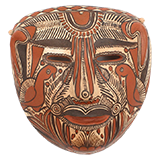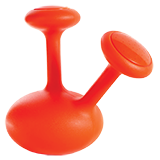1542 Ptolemy "Geographia Universalis" Second Edition Edited by Sebastian Münster
Item Details
A 1542 folio of Geographia Universalis: Uetus et Nova Complectens Claudii Ptolemaei Alexandrini enarrationis libros VIII by Caludius Ptolemaeus (better known as Ptolemy, Egyptian, 100-170 CE), the second edition edited by Sebastian Münster (German, 1488-1552). Translated from Greek into Latin by Willibald Pirckheimer (German, 1470-1530) and published by Heinrich Petri (Henricum Petrum) in Basel in March 1542. This significant cartographic work features thirty-six double-page woodcut maps, of the original forty-eight, including Novae Insulae XVII Nova Tabula depicting the North and South American continents, labeled “Novus Orbis” (“New World”), as discrete continents. This map, when printed in the 1540 first edition edited by Sebastian Münster, was the first to label the body of water west of the continents as the Pacific Ocean. It was largely unknown to Europeans until it was sighted by Vasco Núñez de Balbao (Spanish, circa 1475-1519) in 1513, who called it the mar del sur (the South Sea). Ferdinand Magellan (Portuguese, circa 1480-1521) led a Spanish expedition in 1520 and dubbed it the Pacific Ocean, as he perceived it as calm in comparison to the Atlantic. In addition to the thirty-six complete maps, seven half-page partial maps are present, though maps 1-4 and 30 are missing. (See detailed list below)
Sebastian Münster, born near Mainz in 1488, was a German cartographer and Hebraist scholar who played a significant role in the tumultuous landscape of early 16th century Germany. His personal history is entwined in the development of early printing history, the Reformation, and cartography and the exploration of the New World. Münster joined the Franciscan order in 1505 and attended the University of Tübingen under the mathematician and astronomer Johannes Stöffler (1452-1531), completing his studies in 1518. He left the Franciscans in 1529 and joined the new Lutheran denomination, accepting a position at the University of Basel (aligned with the Protestant movement). He is best known for his Cosmographia, first published in 1544, featuring the first German-language description of the world. Münster published four editions of Geographia in his lifetime (1540, 1542, expanded third edition in 1545, and 1552).
Geographia was originally written by Claudius Ptolemy in Greek circa 150 CE. The work includes a cartographical treatise, a gazetteer, and atlas organized into eight books. Arabic translations were widespread by the 9th century CE and it was first translated into Latin by Jacobus Angelus (Jacopo d’Angelo) of Scarperia circa 1406. Geographia was first published in 1477 with 27 copperplate maps, with several subsequent editions by 1500. As European voyages began to explore the New World, cartographers used Geographia as a platform to publish new locations and improve upon Ptolemy’s work. Using Ptolemy’s scientific framework, notably latitude and longitude (illustrations on pages 140, 142, and 155), maps began to greatly improve from the medieval allegorical maps. This edition features expanded and new maps reflective of the expanding cartographic knowledge of European map makers.
2°: a 3 , * 6 , a–c 6 , A–N 6 , 79 leaves of unmarked tipped in maps (see note for specifics), Aa–Bb 6 , Cc 8 ; 204 leaves; pp. [ 1 ] – [ 52 ] (unnumbered); 1 – [ 156 ]; [ 1 ] – [ 158 ] (unnumbered, tipped in maps); 157 – [ 196 ]
List of included maps:
36 full, double-page woodcut maps, 7 half-page, partial woodcut maps, missing maps #1-4, 30 (including world map)
All maps are tipped in
(5) Tabula Europae I (Britain & Ireland)
(6) Tabula Europae IIII (Germany)
(7) Tabulae Europae V (Italy & Corsica)
(8) Tabula Europa VI (Italy)
Half-page (Right page only) Europae VII (Sicily)
Half-page (Right page only) Europae VIII
(11) Tabulae Europae IX (Dacia)
(12) Tabulae Europae X (Greece & Macedonia)
(13) Aphricae Tabula I (Mauritania)
(14) Aphricae Tabula II (Africa Minor)
Half-page (Right page only) Aphricae III (Egypt)
(16) Aphricae Tabula IIII (North Africa)
(17) Tabula Asiae I (Asia MInor/Turkey)
(18) Tabula Asiae II (Sarmatia Asiatica)
(19) Tabula Asiae III (Albania & Armenia)
Half-page (Right page only) Asiae IIII (Mesopotamia)
(21) Tabula Asiae V (Syria)
(22) Tabula Asiae VI (Arabia)
(23) Tabula Asiae VII (Scythia)
Half-page (Right page only) Asiae VIII (Scythia)
Half-page (Right page only) Asiae IX (India)
(26) Tabula Asia X (India)
(27) Tabula Asiae XI (India)
(28) Tabula Asiae XII (Sri Lanka)
(29) Europa Prima Nova Tabula (Europe, upside down)
Map 30 not present
(31) Hispania III Nova Tabula (Spain)
(32) Gallia IIII Nova Tabula (France)
(33) Helvetia Prima Rheni et V – Nova Tabula (Switzerland)
(34) Germania VI Nova Tabula (Germany)
(35) Alsatia et Brisgoia II Rheni et VII Nova Tabula (Alsace)
(36) Tertia Rheni Nova Tabula (Rhineland)
Half-page (Right page only, approximately 1 inch of left page) …et IX Nova Tabula (Germany)
(38) Brabantia V – Rheni et X Nova Tabula (Brabant)
(39) Svevia et Bavaria XI Nova Tabula (Bavaria)
(40) Franconia XII Nova Tabula (Franconia)
(41) Scholandia XIII Nova Tabula (Scandinavia)
(43) Polonia et Vngaria XV Nova Tabula (Poland & Russia)
(43) Italia XIIII Nova Tabula (Italy)
[ note: it appears map #42 (Italia XIIII Nova Tabula) is mislabeled as #43 and the order of maps #42 & #43 are reversed ]
(44) Terra Sancta XVI Nova Tabula (“Holy Land”, the Levant)
(45) Novae Insulae XVII Nova Tabula (North and South America labeled “Novvs Orbis” as discrete continents with oceans on either side)
(46) Africa XVIII Nova Tabula (African continent)
(47) India Extrema XIX Nova Tabula (Asian continent)
(48) Lacus Constantiensis XX Nova Tabula (Lake Constance, Germany)
| Binding | Leather |
| Complete Set | Yes |
| Number of Books | 1 |
Condition
- red rot and peeling, significant wear to the binding, front and back covers detached
- page discoloration and foxing
- broken hinges
- tight binding; bowing
- water damage to upper edge
- tears to map #5 (“Tabula Europae I”), #8 (“Tabula Europa VI”), #29 (“Europa Prima Nova Tabula”), #44 (“Terra Sancta XVI Nova Tabula”), and a tear in map #45 (“Novae Insulae XVII Nova Tabula”) in the gutter not affecting the printed area
- significant edgewear, especially to latter section of the text block
- last page (with colophon) detached
- damage to upper corner of leaf 197 (pp. 179/180) with repair, pagination no longer present
Dimensions
Item #
18DCC043-038





























































